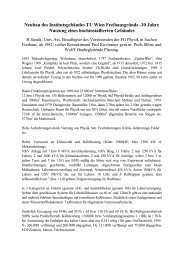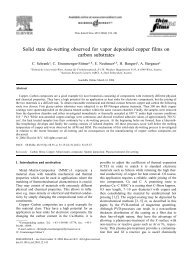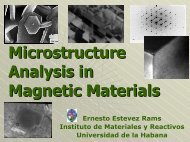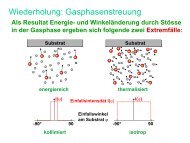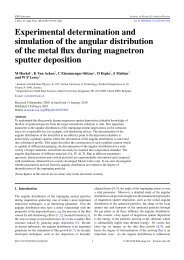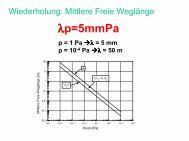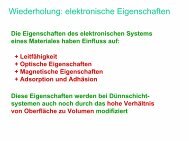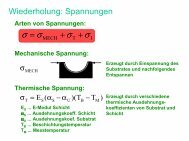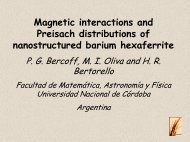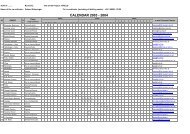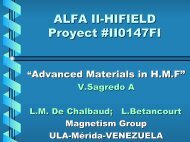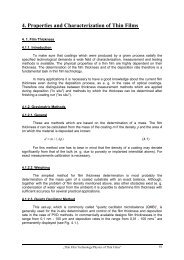Medidas de transporte y magnetismo bajo altas presiones
Medidas de transporte y magnetismo bajo altas presiones
Medidas de transporte y magnetismo bajo altas presiones
You also want an ePaper? Increase the reach of your titles
YUMPU automatically turns print PDFs into web optimized ePapers that Google loves.
<strong>Medidas</strong> <strong>de</strong> <strong>transporte</strong><br />
y <strong>magnetismo</strong> <strong>bajo</strong><br />
<strong>altas</strong> <strong>presiones</strong><br />
Prof. Jesús González<br />
jesusg@ula.ve<br />
CENTRO DE ESTUDIOS DE SEMICONDUCTORES<br />
Facultad <strong>de</strong> Ciencias, Departamento <strong>de</strong> Física,<br />
Universidad <strong>de</strong> Los An<strong>de</strong>s – Mérida<br />
Venezuela
Esquema <strong>de</strong> una celda tipo Bridgman con<br />
sistema <strong>de</strong> calentamiento externo y<br />
conexiones eléctricas para medidas <strong>de</strong><br />
efecto Hall y resistividad [31]
Calibración <strong>de</strong> la presión sobre la muestra<br />
en función <strong>de</strong> la presión hidrólica <strong>de</strong> la<br />
prensa en una celda Bridgman [30]
Depen<strong>de</strong>ncia <strong>de</strong> ρ, n y<br />
µ con la presión en una<br />
muestra <strong>de</strong> InSe<br />
dopada con Sn.
Dispositivo <strong>de</strong> múltiples yunques instalado<br />
en una prensa <strong>de</strong> 250 toneladas en Argonne<br />
National Laboratory [74]
Esquema <strong>de</strong> los yunques <strong>de</strong> WC<br />
Dentro <strong>de</strong> ellos se colocan<br />
ocho cubos <strong>de</strong> pirofilita o<br />
MgO <strong>de</strong> 10 mm <strong>de</strong> longitud<br />
por lado separados por los<br />
espaciadores. Cada cubo<br />
tiene una esquina truncada<br />
triangularmente en una cara;<br />
los ocho truncamientos<br />
forman una cavidad<br />
octaédrica en la cual se<br />
comprime el medio<br />
transmisor <strong>de</strong> presión
Sección diagonal <strong>de</strong> la celda <strong>de</strong> alta presión<br />
Esta celda permite realizar simultáneamente medidas eléctricas y<br />
difracción <strong>de</strong> rayos x <strong>bajo</strong> <strong>altas</strong> <strong>presiones</strong> y <strong>altas</strong> temperaturas
Principio Celda <strong>de</strong> Diamantes<br />
Los yunques <strong>de</strong> diamante se<br />
tallan generalmente con 8 o<br />
16 aristas, esta talla<br />
aproxima mas a un circulo la<br />
forma <strong>de</strong> culata.<br />
Talla Brillante 16 aristas.<br />
Talla Drukker Estándar 8<br />
aristas.<br />
La culata pue<strong>de</strong> ser plana, o<br />
<strong>de</strong> doble pendiente con<br />
ángulos entre 1.5 y 10º.<br />
Dimensiones típicas: 700 mm<br />
hasta 20 GPa, 400 mm hasta<br />
50 GPa
Ley empírica: P max<br />
= 10/d GPa mm -1<br />
Don<strong>de</strong> d es el diámetro <strong>de</strong> la culata, esto es valido para gemas <strong>de</strong> 60 mg<br />
(0.3 carats) y D= 3mm.<br />
Para muy <strong>altas</strong> <strong>presiones</strong>, en diamantes con doble pendiente esto no es<br />
valido y las dimensiones exactas <strong>de</strong>pen<strong>de</strong>n <strong>de</strong> la presión máxima a<br />
alcanzar.<br />
Para <strong>presiones</strong> superiores 1 Mbar , los diamantes se rompen con cierta<br />
frecuencia.
SENSORES DE PRESION ÓPTICOS<br />
RUBI (Al 2 O 3 :Cr 3+ ), luminiscencia ,<br />
doblete R 1 -R 2<br />
λ (R 1 ) = 6942 A 0 Γ= 6 A 0<br />
Ley lineal calibrada con<br />
respecto a la ecuación <strong>de</strong><br />
estado <strong>de</strong> Decker para el<br />
NaCl, valida hasta 30 GPa<br />
∆λ/∆P = 0.365 A 0 Kbar -1<br />
∆λ/∆P = -0.753 cm -1 Kbar -1
Samario<br />
∆λ 0-0<br />
(T> 500)= 1.06x10 -4 (T-500)+1.5x10 -7 (T-500) 2<br />
<strong>Medidas</strong> In- Situ <strong>de</strong> Presión<br />
y Temperatura con los dos<br />
sensores<br />
T=300+137(∆λ R1<br />
-1.443∆λ 0-0<br />
)
Altas Temperaturas<br />
Hornos Resistivos<br />
externos hasta 900 K al<br />
aire, pue<strong>de</strong>n llegar a<br />
1400 K en atmósfera<br />
inerte o al vacío<br />
Rubí: 300< T< 600 K ley lineal<br />
∆λ R1<br />
/∆T= 7.3x10 -3 nmK -1<br />
600< T < 1300 K<br />
∆λ R1<br />
= 2.22+ 7.7x10 -3 ∆T+5.5x10 -6 ∆T 2<br />
∆T=T-600
Calentador Externo
Técnicas para realizar medidas <strong>de</strong> <strong>transporte</strong><br />
en celdas <strong>de</strong> diamante (DAC)<br />
Arreglo utilizado por Sakai et al. [92] para realizar medidas <strong>de</strong> resistividad.<br />
La resistencia <strong>de</strong> carbon sirve como termómetro para medidas <strong>de</strong> bajas<br />
temperaturas.
(a)<br />
(b)<br />
vista superior <strong>de</strong>l arreglo<br />
<strong>de</strong> contactos usado por<br />
J. González et al [95].<br />
vista <strong>de</strong> perfil <strong>de</strong> los<br />
diamantes y el gasket.<br />
Ángulos θ 1 = 11.5°, θ 2 =<br />
23°. (1) culet <strong>de</strong> los<br />
diamantes, (2) junta<br />
metálica, (3) capa <strong>de</strong><br />
alumina, (4) surcos para<br />
los contactos, (5)<br />
muestra
Fotografias <strong>de</strong> muestras<br />
Con contactos eléctricos<br />
Presurizada vista a través<br />
<strong>de</strong> un diamante
Esquema <strong>de</strong>l arreglo experimental<br />
usado en [97]
Vista esquemática <strong>de</strong>l arreglo experimental<br />
usado en [99]<br />
(S) muestra,<br />
(SP) CaSO 4<br />
(W) alambres <strong>de</strong> Cu<br />
(G) Gasket<br />
(HP) polvo <strong>de</strong> Al 2 O 3<br />
(R) Rubíes<br />
(D) diamantes
(A) Esquema <strong>de</strong>l<br />
arreglo<br />
experimental<br />
usado para las<br />
medidas eléctricas<br />
en [100]<br />
(B) Disposición <strong>de</strong><br />
electrodos<br />
observada a 220<br />
GPa
Esquema experimental usado para realizar<br />
medidas <strong>de</strong> po<strong>de</strong>r termoeléctrico en una<br />
celda <strong>de</strong> diamantes
Depen<strong>de</strong>ncia en temperatura <strong>de</strong> ρ a<br />
diferentes <strong>presiones</strong> en<br />
(La 0.6<br />
Nd 0.4<br />
) 1.2<br />
Sr 1.8<br />
Mn 2<br />
O 7
Resistividad <strong>de</strong>l FeS<br />
en función <strong>de</strong> la<br />
presión<br />
Resistividad <strong>de</strong>l GeSe<br />
en función <strong>de</strong> la<br />
presión
Resistividad (■) y po<strong>de</strong>r termoeléctrico<br />
(●) en función <strong>de</strong> la presión en una<br />
muestra <strong>de</strong> HgTe 0.52 S 0.48
Variación <strong>de</strong>l<br />
coeficiente<br />
<strong>de</strong> Hall y <strong>de</strong><br />
la movilidad<br />
con la<br />
presión
Esquema <strong>de</strong> la configuración<br />
para magnetorresistencia
Curvas <strong>de</strong> magnetorresistencia <strong>de</strong>l CeRu 2 Ge 2<br />
a 100 mK a diferentes <strong>presiones</strong>
Arreglo típico usado para las<br />
medidas <strong>de</strong> po<strong>de</strong>r termoeléctrico
Esquema ilustrando la técnica <strong>de</strong> análisis<br />
térmico diferencial<br />
Curvas <strong>de</strong> DTA a<br />
distintas <strong>presiones</strong><br />
en una aleación <strong>de</strong><br />
TiZr
Metalización <strong>de</strong>l ZnSe inducida por la presión<br />
Depen<strong>de</strong>ncia <strong>de</strong> la resistencia<br />
con la presión a 300 K<br />
Depen<strong>de</strong>ncia <strong>de</strong> la resistividad con<br />
la temperatura a distintas <strong>presiones</strong>.<br />
(a) valor absoluto. (b) curvas<br />
normalizadas con R(T=100 K)
(A) Depen<strong>de</strong>ncia en presión <strong>de</strong> la resistividad <strong>de</strong>l CsI a 10 K (□) y<br />
a 300 K (●); <strong>de</strong>ntro <strong>de</strong> la figura se muestra como entre 108<br />
GPa y 117 GPa la característica <strong>de</strong> la conductividad cambia<br />
<strong>de</strong> semiconductora a metálica<br />
(B) Comportamiento típico <strong>de</strong> la fase semiconductora y <strong>de</strong> la fase<br />
metálica sobre un amplio rango <strong>de</strong> temperatura
Depen<strong>de</strong>ncia en presión <strong>de</strong> la<br />
resistividad <strong>de</strong>l B a 300 K<br />
En el interior <strong>de</strong> la figura se<br />
pue<strong>de</strong> ver la luz transmitida a<br />
175 GPa a través <strong>de</strong> una<br />
muestra <strong>de</strong> B <strong>de</strong> 15 µm (zona<br />
más clara) y <strong>de</strong> la mezcla <strong>de</strong><br />
BN y epoxy (zona más oscura)<br />
colocada en el interior <strong>de</strong>l<br />
gasket <strong>de</strong> Re (zona oscura).<br />
Los electrodos <strong>de</strong> paladio en<br />
una configuración <strong>de</strong> cuasicuatro<br />
puntas también se<br />
pue<strong>de</strong>n ver.
<strong>Medidas</strong> eléctricas <strong>de</strong>l<br />
oxigeno molecular
Celda <strong>de</strong> presión <strong>de</strong> membrana<br />
1. Diamond anvil<br />
2. Anvil ring<br />
3. Crabi<strong>de</strong> support plate<br />
4. Lower carbi<strong>de</strong> fixing plate<br />
5. Hemisphere<br />
6. Inner piston<br />
7. Upper anvil retaining<br />
plate<br />
8. Outer piston<br />
9. Inner cylin<strong>de</strong>r<br />
10. Outer/inner piston fixing<br />
screws<br />
11. Cell body/outer cylin<strong>de</strong>r<br />
12. Top plate<br />
13. Washer<br />
14. Loading bolts, ¼” UNF<br />
lh/rh<br />
B Hemisphere / tilt<br />
adjustement screws
Celdas <strong>de</strong> diamante<br />
para adaptar en<br />
criostatos
Diferentes celdas <strong>de</strong> diamante
Celda <strong>de</strong> diamante<br />
acoplada a un crióstato<br />
comercial
Montaje propuesto para<br />
el alto campo
Esquema <strong>de</strong> contactos
Celdas <strong>de</strong> presión <strong>de</strong><br />
diferentes tamaños
Blibliografía<br />
1. P.W. Bridgman, Phys. Rev. 48, 893 (1935).<br />
2. A. Jayaraman and R.G. Maines, Natl. Bur. Stand. (U.S.) Spec. Publ. 326, 5 (1971).<br />
3. G. Fasol and J. S. Schilling, Rev. Sci. Instrum. 41, 1722 (1978).<br />
4. J.M. Besson, G. Hamel, P. Grima, R. J. Nelmes, J. Loveday, S. Hull, and D. Häusermann, High<br />
Pres. Res. 8, 625 (1992).<br />
5. N. Kawai and S. Endo, Rev. Sci. Instrum. 41, 1178 (1970).<br />
6. N. Kawai, M. Togaya, and A. Ono<strong>de</strong>ra, Proc. Jpn. Acad. 49, 623 (1973).<br />
7. H.K. Mao and P.M. Bell, Carnegie Institution of Washington Year Book 75, 824 (1976).<br />
8. S. Block, R. A. Forman, and G.J. Piermarini, High Pressure Research: Applications in<br />
Geophysics, edited by M.H. Manghnani and S. Akimoto (Aca<strong>de</strong>mic, New York, 1977) p. 503.<br />
9. J.L. van <strong>de</strong>r Pauw, Phyllips Research Report 13, 1 (1955).<br />
10. G.C. Kennedy and R.C. Newton, Solids un<strong>de</strong>r Pressure (McGraw-Hill, New York, 1963).<br />
11. M.I. Eremets, High-Pressure Experimental Methods (Oxford University Press, Oxford, 1996).<br />
12. T. Suski, High Pressure in Semiconductor Physics I, edited by T. Suski and W. Paul (Aca<strong>de</strong>mic<br />
Press, San Diego, 1998) p. 485.<br />
13. D.H. Newhall, Instrum. Control Systems (1962).<br />
14. Generalmente se usa un alambre <strong>de</strong> manganina <strong>de</strong> 0.1 mm <strong>de</strong> diámetro. La variación relativa <strong>de</strong><br />
la resistividad <strong>de</strong>l sensor <strong>de</strong> manganina <strong>de</strong>pen<strong>de</strong> <strong>de</strong>l fabricante y <strong>de</strong>l tipo <strong>de</strong> sensor utilizado.<br />
Dicha calibración es provista por el fabricante. Un valor típico es 0.27 % por kilobar. Uno <strong>de</strong> los<br />
fabricantes <strong>de</strong> sensores <strong>de</strong> manganina es: Vishay Measurements Group<br />
[www.vishay.com/brands/measurements_group/gui<strong>de</strong>/500/lists/mg_list.htm].<br />
15. F. Datchi, P. Loubeyre, and R. LeToullec, Phys. Rev. B 61, 6535 (2000).<br />
16. M. Oszwaldowski and T. Berus, phys. stat. sol. (a) 161, 143 (1997).<br />
17. D. Chadi and K. Chang, Phys. Rev. Letters 61, 873 (1988).
18. M. Mizuta, M. Tachikawa, H. Kukimoto, and S. Minomura, Jpn. J. Appl. Phys. 24, L143 (1985).<br />
19. T. Suski, R. Piotrzkowski, P. Wisniewski, E. Litwin-Staszewsska, and L. Dmowski, Phys. Rev. B 40,<br />
4012 (1989).<br />
20. D. Errandonea, A. Segura, J.F. Sánchez-Royo, V. Muñoz, P. Grima, A. Chevy, and C. Ulrich, Phys.<br />
Rev. B 55, 16217 (1997).<br />
21. A. Segura, B. Marí, J.P. Martínez-Pastor, and A. Chevy, Phys. Rev. B 43, 4953 (1991).<br />
22. K. Kamenev, M. R. Lees, G. Balakrishnan, C.D. Dewhurst, and D. Mc.Paul, Physica B 265, 191<br />
(1994).<br />
23. Sensores resistivos <strong>de</strong> óxido <strong>de</strong> nitrógeno <strong>de</strong> alta sensibilidad. Rango <strong>de</strong> tra<strong>bajo</strong> 1 K – 325 K.<br />
Fabricados por Lake Shore [www.lakeshore.com/temperature/cernox_productpage.html].<br />
24. P.W. Bridgman, Proceedings of the American Aca<strong>de</strong>my of Arts and Sciences 51, 167 (1952).<br />
25. Material cerámico compuesto por: 58% SiO2, 26-32% MgO, 3-6% Al2O3 y 1.3% Na2O.<br />
26. La pirofilita primero fluye plásticamente hasta llegar a un límite en el que <strong>de</strong>ja <strong>de</strong> <strong>de</strong>formarse por<br />
haber adquirido un módulo <strong>de</strong> <strong>de</strong>formación plástica muy gran<strong>de</strong>. La resistividad eléctrica <strong>de</strong> la<br />
pirofilita es ~ 10 KW cm y su conductividad térmica es ~ 9.5 10-3 cal/cm s K.<br />
27. M. Nishikawa and S. Akimoto, High Temp. – High Press. 3, 531 (1987).<br />
28. M. Wakatsuki, K. Ichinose, and T. Akoi, Jpn. J. Appl. Phys. 10, 357 (1971).<br />
29. A.K. Bandyopadhya, S. Chatterjee, E.S.R. Gopal, and S.V. Subramanyam, Rev. Sci. Instrum. 32,<br />
1232 (1981).<br />
30. T.K. Mondal, S. Murugavel, and S. Asokan, Rev. Sci. Instrum. 70, 165 (1999).<br />
31. D. Errandonea, Tesis Doctoral, Universidad <strong>de</strong> Valencia (1998).<br />
32. D. Mc.Whan, M. I.Rice, and P.H. Schmidt, Phys. Rev. 171, 1063 (1969).<br />
33. R.A. Stager and H.G. Drickamer, Science 139, 1284 (1963).
34. G.C. Kennedy and P.N. Lamori, in Progress in Very High-Pressure Research, edited by F.P. Bundy,<br />
W.R. Hibard, and H.M. Strong (Willey, New York, 1961) p. 304.<br />
35. J. Witting and C. Probst, High Pressure and Low Temperatures, edited by C.W. Chu and J.A. Woollam,<br />
(Plenum, New York, 1983) p. 443.<br />
36. D. Jaccard, E. Vargoz, K. Alami-Yadri, and H. Wilhelm, Rev. High Pressure Sci. Technol. 7, 412<br />
(1998).<br />
37. P.W. Bridgman, Phys. Rev. 60, 351 (1941).<br />
38. W. Klement Jr., A. Jayaraman, and G.C. Kennedy, Phys. Rev. 131, 632 (1963).<br />
39. M.A. Ill’na and E.S. Itskevich, Sov. Phys. Solid State 8, 1873 (1967).<br />
40. G.C. Kennedy and P.N. Lamori, J. Geophys. Res. 67, 851 (1962).<br />
41. P.S. Balog and R.A. Secco, phys. stat. sol. (b) 214, 357 (1999).<br />
42. V.E. Bean et al., Proceedings of the Xth AIRAPT International High Pressure Conference on Research<br />
in High Pressure Science and Technology, Amsterdam (1985) p. 144.<br />
43. Termopar tipo K, Chromel: 90 Ni, 10Cr, Alumel: 96 Ni, 2 Mn, 2 Al.<br />
44. F.P Bundy, J. Appl. Phys. 32, 483 (1961).<br />
45. G.C. Kennedy and R.C. Newton, J. Geophys. Res. 66, 1491 (1961).<br />
46. R.E. Hanneman and H.M. Strong, J. Appl. Phys. 37, 612 (1966).<br />
47. I.C. Getting and G.C. Kennedy, J. Appl. Phys. 41, 4552 (1970).<br />
48. S.P. Brey, R. Weber, and K.B. Nickel, J. Geophys. B 95, 15603 (1990).<br />
49. M.W. Schaefer and A.W. Webb, Rev. Sci. Instrum. 59, 1312 (1988).<br />
50. F.J. Manjón, D. Errandonea, A. Segura, V. Muñoz, G. Tobias, P. Or<strong>de</strong>jon, and E. Cana<strong>de</strong>ll, Phys. Rev.<br />
B 63, 125330 (2001).<br />
51. Nicrom (Nichrome): 75Ni, 12Fe, 11Cr, 2Mn, r = 1.5 KW cm.<br />
52. N.W. Ashcroft and N.D. Mermin, Solid State Physics (Saun<strong>de</strong>rs College, 1976).<br />
53. J.K. Furdyna, J. Appl. Phys. 64, R29 (1988).
54. S. Von Molnar, A. Briggs, J. Flouquet, and G. Remenyi, Phys. Rev. Letters 51, 706 (1981).<br />
55. H. Wilhelm and D. Jaccard, Solid State Comun. 106, 239 (1998).<br />
56. B. Bireckhoven and J. Witting, J. Phys. 21, 841 (1998).<br />
57. W.G. Marshall and D.J. Francis, J. Appl. Crystallography 122 (2002).<br />
58. V.V. Shchennikov, A.E. Kar’kin, N.P. Gavaleshko, and V.M. Frasunyak, Physics of the Solid State 42,<br />
215 (2000).<br />
59. A.Y. Mollaev, L.A. Saypulaeva, R.K. Arslanov, S.F. Gabibov, and S.F. Marenkin, High Pres. Res. 22,<br />
181 (2002).<br />
60. A.Y. Mollaev, L.A. Saipulaeva, R.K. Arslanov, S.F. Gabibov, S.F. Marenkin, and A.Y. Vol'fkovich,<br />
Inorganic Materials 38, 201 (2002).<br />
61. E.S. Itskevich and V.F. Krai<strong>de</strong>nov, Physics Solid State 43, 1267 (2001).<br />
62. L.G. Khvostantsev and V.A. Sidorov, phys. stat. sol. (a) 64, 379 (1981).<br />
63. L.G. Khvostantsev, V.A. Sidorov, L.E. Shelimova, and N.Kh. Abrikosov, phys. stat. sol. (a) 74, 185<br />
(1982).<br />
64. O.B. Tsiok, V.V. Bredikhin, V.A. Sidorov, and L.G. Khvostantsev, High Pres. Res. 10, 523 (1992).<br />
65. A.K. Singh and G. Ramani, Rev. Sci. Instrum. 49, 1324 (1978).<br />
66. D.A. Polvani, J.F. Meng, M. Hasegawa, and J.V. Badding, Rev. Sci. Instrum. 70, 3586 (1999).<br />
67. V.V. Shchennikov, V.I. Osotov, N.P. Gavaleshko, et al. In High Pressure Science and Technology, ed.<br />
by W.A. Trzeciakowski (World Sci., Singapore, 1996) p. 493.<br />
68. L.G. Khvostantsev, L.F. Vereschagin, and N.M. Uliyanitskaya, High Temp. – High Press. 5, 261<br />
(1973).<br />
69. A.L. Edwards and H.G. Drickamer, Phys. Rev. 122, 1149 (1961).<br />
70. P.W. Bridgman, Proc. Am. Acad. Sci. 74, 21 (1940).<br />
71. A.N. Mariano and E.P. Warekois, Science 142, 672 (1963).
72. U. Schwarz, A.R. Goñi, K. Syassen, A. Cantarero, and A. Chevy, High Pres. Res. 8, 396 (1991).<br />
73. M.J. Walter, Y. Thibault, K. Wei, and R.W. Luth, Canadian Journal of Physics 73, 273 (1995).<br />
74. M.T. Vaughan, D.J. Weidner, Y.B. Wang, J.H. Chen, C.C. Koleda, and I.C. Getting, Proceedings of<br />
International Conference AIRAPT-16 and HPJC-38, ed. by M. Nakamura, Rev. High Pressure Sci.<br />
Technol., 7, 1520 (1998).<br />
75. N. Môri, Y. Okayama, H. Takashi, Y. Haga, and T. Suzuki, Jpn. J. Appl. Phys. 8, 182 (1993).<br />
76. R.A. Secco, M.H. Manghnani, L.C. Ming, X. Li, and J.A. Xu, in High-Pressure Research in Mineral<br />
Physics: Applications to Earth and Planetary Sciences, ed. by Y. Syono and M.H. Manghnani (Terra<br />
Scientifc, Tokio, 1992) p. 477.<br />
77. A. Ono<strong>de</strong>ra, High Temp. – High Press. 19, 579 (1987).<br />
78. H. Kobayashi, N. Takeshita, N. Môri, H. Takahashi, and T. Kamimura, Phys. Rev. B 63, 115203<br />
(2001).<br />
79. A. Ono<strong>de</strong>ra, I. Sakamoto, Y. Fujii, N. Môri, and S. Sugai, Phys. Rev. B 56, 7935 (1997).<br />
80. R. Secco and E. Secco, Phys. Rev. B 56, 3099 (1997).<br />
81. X. Li, M.H. Manghnani, L-C. Ming, and D.E. Grady, J. Appl. Phys. 80, 3860 (1996).<br />
82. W. Klement Jr., A. Jayaraman, and G.C. Kennedy, Phys. Rev. 131, 1 (1963).<br />
83. A. Jayaraman, W. Klement Jr., and G.C. Kennedy, Phys. Rev. 130, 2277 (1963).<br />
84. A. Jayaraman, Phys. Rev. 139, A165 (1965).<br />
85. A. Jayaraman, W. Klement Jr., and G.C. Kennedy, Phys. Rev. 132, 1620 (1964).<br />
86. A. Jayaraman, W. Klement, R.C. Newton, and G.C. Kennedy, J. Phys. Chem. Solids 24, 7 (1963).<br />
87. A. Jayaraman, W. Klement Jr., and G.C. Kennedy, Phys. Rev. 131, 644 (1963).<br />
88. F.X. Zhang and W.K. Wang, Phys. Rev. B 52, 3113 (1995).<br />
89. V.V. Brazhkin, A.G. Lyapin, L.G. Khvostantsev, V.A. Sidorov, O.B. Tsiok, S.C. Bayliss, A.V. Sapelkin,<br />
and S.M. Clark, Phys. Rev. B 54, 1808 (1996).
90. I.O. Bashkin, A. Yu Pagnuev, A.F. Gurov, V.K. Fedotov, G.E. Abrosimova, and E.G. Ponyatovski,<br />
Phys. of the Solid State 42, 170 (2000).<br />
91. S. Block and G. J. Piermarini, Phys. Today 29, 44 (1976).<br />
92. N. Sakai, T. Kajiwara, K. Tsuji, and S. Monimura, Rev. Sci. Instrum. 53, 499 (1982).<br />
93. H.K. Mao and P.M. Bell, Rev. Sci. Instrum. 52, 615 (1981).<br />
94. S.W. Tozer and H.E. King Jr., Rev. Sci. Instrum. 56, 260 (1985).<br />
95. J. Gonzalez, J.M. Besson, and G. Weill, Rev. Sci. Instrum. 57, 106 (1986).<br />
96. D. Patel, T.E. Crumbaker, J.R. Sites, and I.L. Spain, Rev. Sci. Instrum. 57, 2795 (1986).<br />
97. H.K. Mao, J. Xu, and P.M. Bell, J. Geophys. Res. 14, 4342.<br />
98. D. Erskine, P. Yu, and G. Martinez, Rev. Sci. Instrum. 58, 406 (1987).<br />
99. G. Itkin, G.R. Hearne, E. Sterer, M. Pasternak, and W. Potzel, Phys. Rev. B 51, 3195 (1995).<br />
100. M.I. Eremets, K. Shimizu, T.C. Kobayashi, and K. Amaya, Science 281, 1333 (1998).<br />
101. M.I. Eremets, E.A. Gregoryanz, V.V. Struzhkin, H.K. Mao, R.J. Hemley, N. Mul<strong>de</strong>rs, and N.M.<br />
Zimmerman, Phys. Rev. Letters 85, 2797 (2000).<br />
102. M. Bastea, A.C. Mitchell, and W.J. Nellis, Phys. Rev. Letters 86, 3108 (2001).<br />
103. M.I. Eremets, V.V. Struzhkin, H.K. Mao, and R.J. Hemley, Science 293, 272 (2001).<br />
104. R. Boehler, N. von Bargen, and A. Chopelas, J. Geophys. Res. 95, 21731 (1990).<br />
105. R. Boehler, Nature 363, 534 (1993).<br />
106. D. Errandonea, R. Boehler, and M. Ross, Phys. Rev. Letters 85, 3444 (2000).<br />
107. D. Errandonea, R. Boehler, and M. Ross, Phys. Rev. B 63, 132104 (2001).<br />
108. D. Errandonea, R. Boehler, and M. Ross, Phys. Rev. B 65, 012108 (2002).<br />
109. G.A. Samara, Phys. Rev. B 27, 3494 (1983).<br />
110. D. Errandonea, A. Segura, V. Muñoz, and A. Chevy, Phys. Rev. B 60, 15866 (1999).<br />
111. M.-F. Li and P.Y. Yu, High Pressure in Semiconductor Physics I, edited by T. Suski and W. Paul<br />
(Aca<strong>de</strong>mic Press, San Diego, 1998) p. 457.
112. G.A. Samara, Phys. Rev. 165, 959 (1968).<br />
113. G.A. Samara, Phys. Rev. B 13, 4529 (1976).<br />
114. G. Martinez, Handbook of Semiconductors, ed. by J.S. Moss and M. Balkanski (North Holland,<br />
Amsterdam, 1980), vol. 2 p. 181.<br />
115. D. Penn, Phys. Rev 128, 2093 (1962).<br />
116. R. Trommer, H. Müller, M. Cardona, and P. Vogl, Phys. Rev. B 21, 4869 (1980).<br />
117. M. Gauthier, A. Polian, J.M. Besson, and A. Chevy, Phys. Rev. B 40, 3837 (1989).<br />
118. M. Mejatty, A. Segura, R. Le Toulec, J.M. Besson, A. Chevy, and H. Fair, J. Phys. Chem. Solids 39,<br />
25 (1978).<br />
119. H. d’Amour, W.B. Holzapfel, A. Polian, and A. Chevy, Solid State Comun. 44, 853 (1982).<br />
120. C.T. Sah, L. Forbes, L.L. Rosier, and A.F. Tasch, Solid State Electron. 13, 759 (1970).<br />
121. C.T. Sah, Solid State Electron. 19, 975 (19750.<br />
122. D.V. Lang, J. Appl. Phys. 45, 3023 (1974).<br />
123. G.L. Miller, D.V. Lang, and L.C. Kimerling, Ann. Rev. Mater. Sci. 7, 377 (1977).<br />
124. H.G. Grimmeis, Ann. Rev. Mater. Sci. 7, 343 (1977).<br />
125. E. Calleja, F. Garcia, A. Gomez, E. Muñoz, P.M. Mooney, T.N. Morgan, and S.L. Wrigth, Appl. Phys.<br />
Lett. 56, 934 (1990).<br />
126. S. Arumugam and N. Môri, Physica C 341-348, 1559 (2000).<br />
127. M. Bastea and S. Bastea, Phys. Rev. B 65, 193104 (2002).



